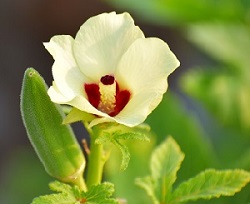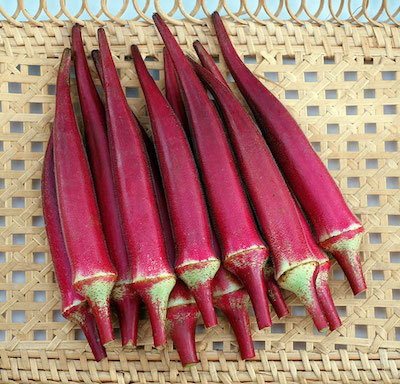Okra: An Important Vegetable Around the World
By Janet Scheren, Fairfax Master Gardener
Bhindi, Ochinggômbo, Ki-Ngombo, Quimbombó, Lady Fingers, Ochro, Bammia . . .
 To most of us it’s plain old okra — a most beloved or most hated vegetable. Despite what you may think of it personally, we know what scientists thought of it when they named it — esculentus, which is Latin for ‘being fit for human consumption.’ And indeed Abelmoschus esculentus is quite fit for human consumption. In warm, moist climates around the world, okra has become an important, life-sustaining staple crop — eaten raw, fried, boiled, in stews and soups, ground to make flour and as a flower. It can also be used as a medicinal herb or as a salve for the skin.
To most of us it’s plain old okra — a most beloved or most hated vegetable. Despite what you may think of it personally, we know what scientists thought of it when they named it — esculentus, which is Latin for ‘being fit for human consumption.’ And indeed Abelmoschus esculentus is quite fit for human consumption. In warm, moist climates around the world, okra has become an important, life-sustaining staple crop — eaten raw, fried, boiled, in stews and soups, ground to make flour and as a flower. It can also be used as a medicinal herb or as a salve for the skin.
Okra more than holds its own on the nutrition front, boasting ample quantities of vitamin C, vitamin K, magnesium, calcium and many of the B vitamins. It is also rich in dietary fiber, trace minerals and antioxidants — all of this while staying low in carbohydrates. And all that mucilage (a nice way to reference the slime) helps remove toxins from the body and can be very soothing to the skin, throat and respiratory system!

Okra flower
As a member of the mallow family, its flowers look like glorious hibiscus blossoms. So, go ahead and foodscape it as a feature in your front garden if you like. Okra are prolific producers, and you can wind up with more pods than you can eat. Fortunately, those stunning flowers are also edible and make great additions to salads.
Okra seed should be sown outdoors when soil temperatures are above 65 degrees in well-drained soil. For an earlier harvest, you can sow seeds indoors five to six weeks before your last frost date. Okra has a hard seed coat that can make it difficult to germinate. So, try a scarification technique, such as scratching the seeds with sandpaper or a wood rasp and soaking them for 12 to 24 hours before planting. Space plants 12 to 18 inches apart with 36 to 48 inches between rows. Okra takes between 50 and 60 days to reach maturity after transplanting. It can reach up to 6 to 10 feet, so that’s another reason to give okra plenty of room to grow.
As a heavy feeder, it likes soil high in organic matter with a soil pH around 6. If you fertilize, don’t overdo the nitrogen component, which can result in lots of growth but reduced flower and fruit production.
Although okra is fairly drought tolerant, it’s critical to keep a uniform soil moisture level for pods to set and develop. Okra should be harvested while small, within just a few days after it develops from the pollinated flower. Most plants are spiny, so you’ll want to wear gloves when you harvest.
Harvest okra often — typically three times as week — using clippers or a sharp knife to cut pods at their base. The pods become tough and fibrous as they mature, making them inedible. If you wait too long to pick them, the seeds will be fully developed, and the plant will think it has completed its life cycle. This reduces productivity. Harvest young tender pods often, and clip and discard or compost any pods that have begun to mature.
Additionally, okra may slow or cease flower production in the hottest and driest part of the summer from mid-July to mid-August. If this happens, try cutting the stems to 6 to 12 inches above the soil, then fertilize and irrigate to stimulate new growth. You may be rewarded with flowers and fruit until frost.

Okra ‘Candle Fire’
While most of us think of okra as just okra, there are many forms and colors — long pod, stubby pod, spineless, velvety, red, green and white. Varieties recommended by Clemson University specialists include Clemson Spineless 80, Lee, Annie Oakley II, Cajun Delight, Choppee and Burgundy.
In addition to Clemson Spineless, well known Virginia author Ira Wallace recommends two varieties for gardening in our area: Cajun Jewel, a dwarf plant with showy leaves and abundant delicious pods; and Hill County Heirloom, which she calls an edible and ornamental hedge plant.
Fortunately, okra has few noticeable pests. Pods curled or with wart-like protrusions commonly indicate earlier feeding damage by stink bugs and/or leaffooted bugs. It may also suffer damage from aphids. Corn earworms also infest pods occasionally. Damage to the foliage is normally unimportant. Companion plants can help with these issues. Good companions for okra include cucumbers, peppers, basil and other fragrant herbs, and the full array of flowering annual companions, including cosmos, zinnias and calendulas. These companion plants draw beneficial insects and also provide strong fragrances that repel or confuse the bad bugs.
Resources
• Okra, University of Maryland Extension, Home & Garden Information Center
• Grow Great Virginia Vegetables, Ira Wallace, 2020, Timber Press
• Basics for Growing Okra, Nancie Mandeville, North Carolina Agricultural and Technical State University,
Union County Center
• Pests of Okra, Kenneth Sorensen, James Baker, Cathy Cameron Carter, David Stephan, North Carolina
State University Extension
• The Whole Okra, A Seed to Stem Celebration, Chris Smith, 2019, Chelsea Green Publishing
• Okra Fact Sheet, Powell Smith, Bob Polomski, Debbie Shaughnessy, Zack Snipes, Clemson University
Cooperative Extension
• Choppee Okra, Clemson Heirloom Collection, Clemson University, College of Agriculture